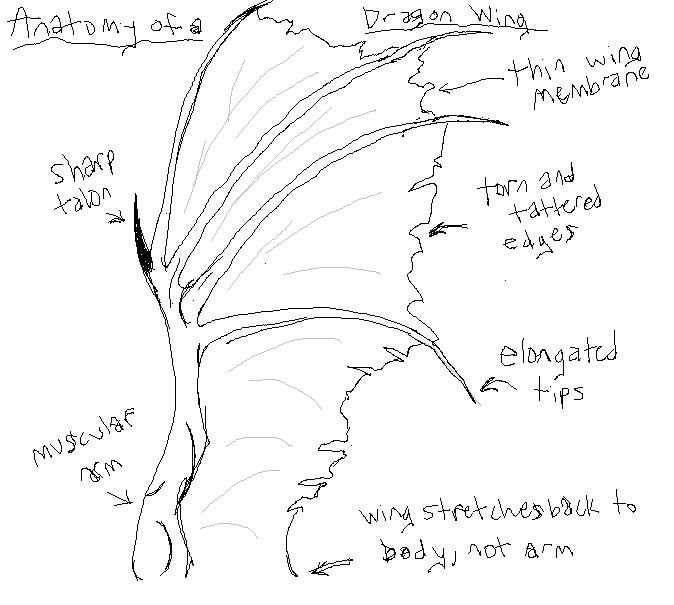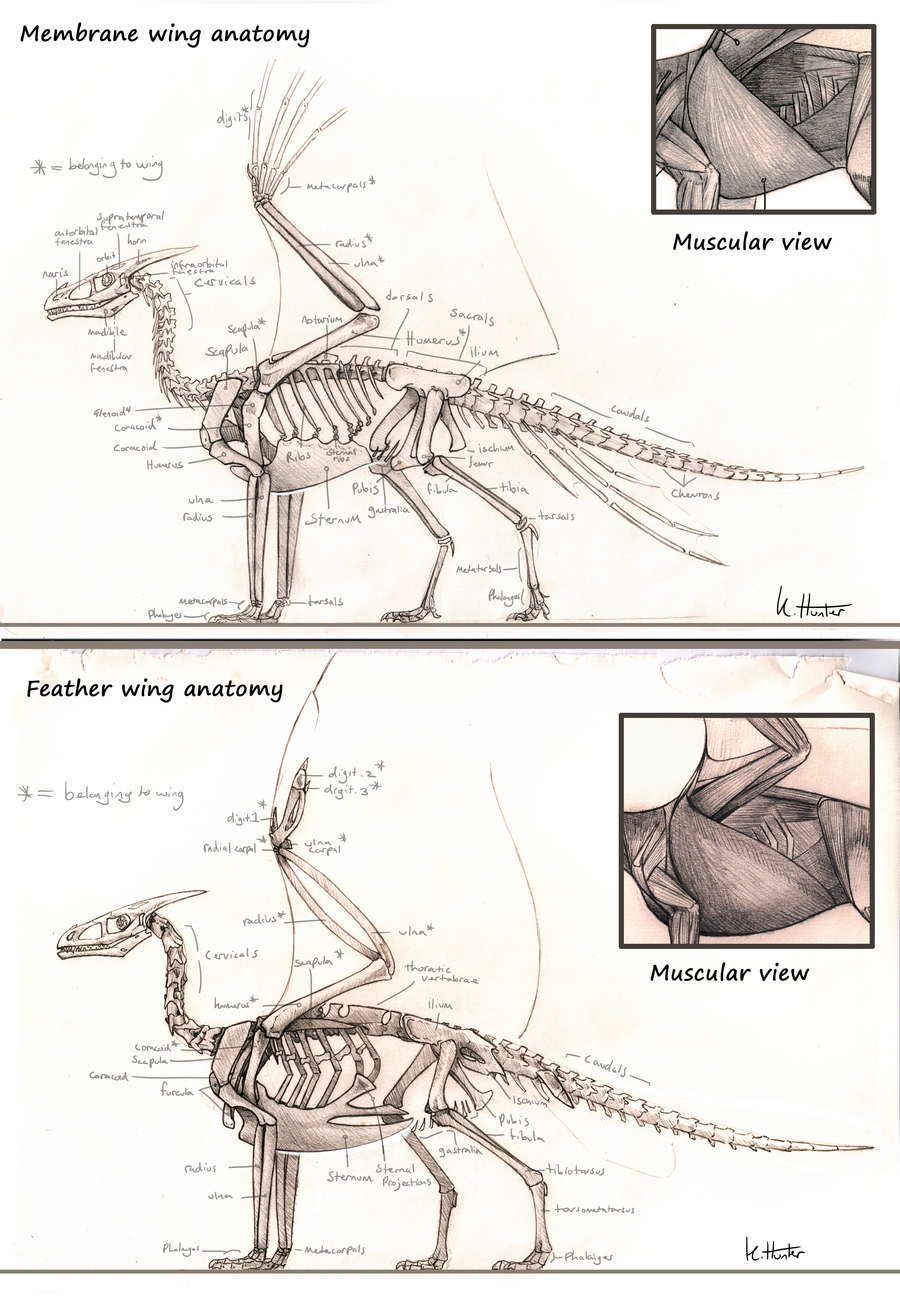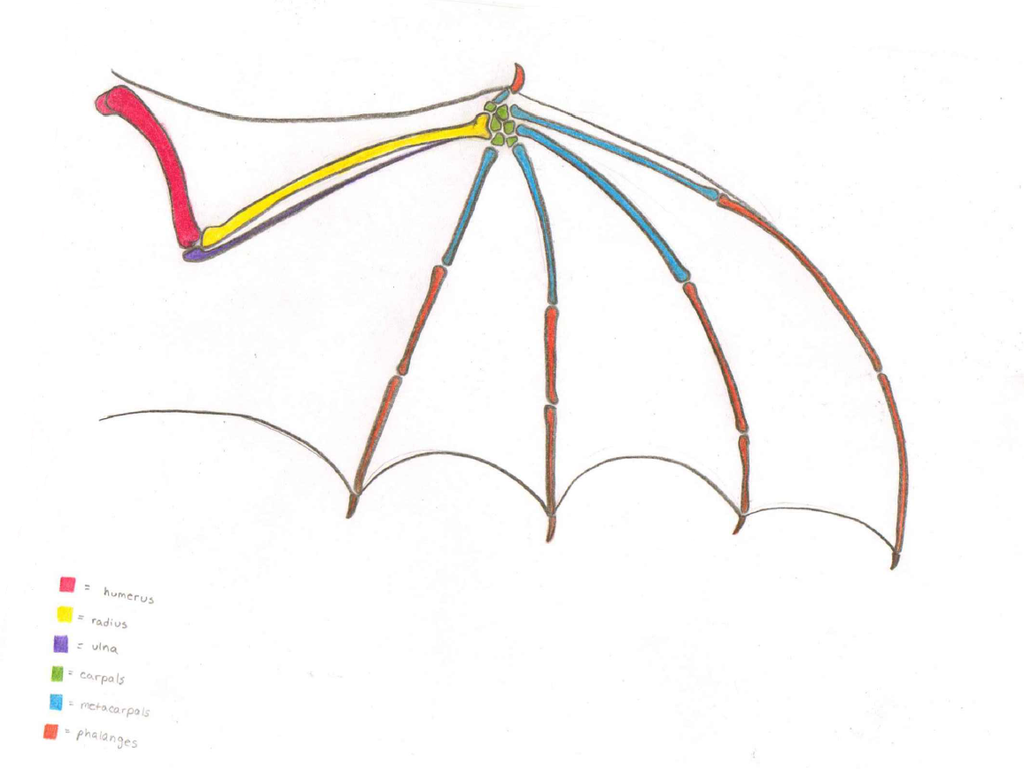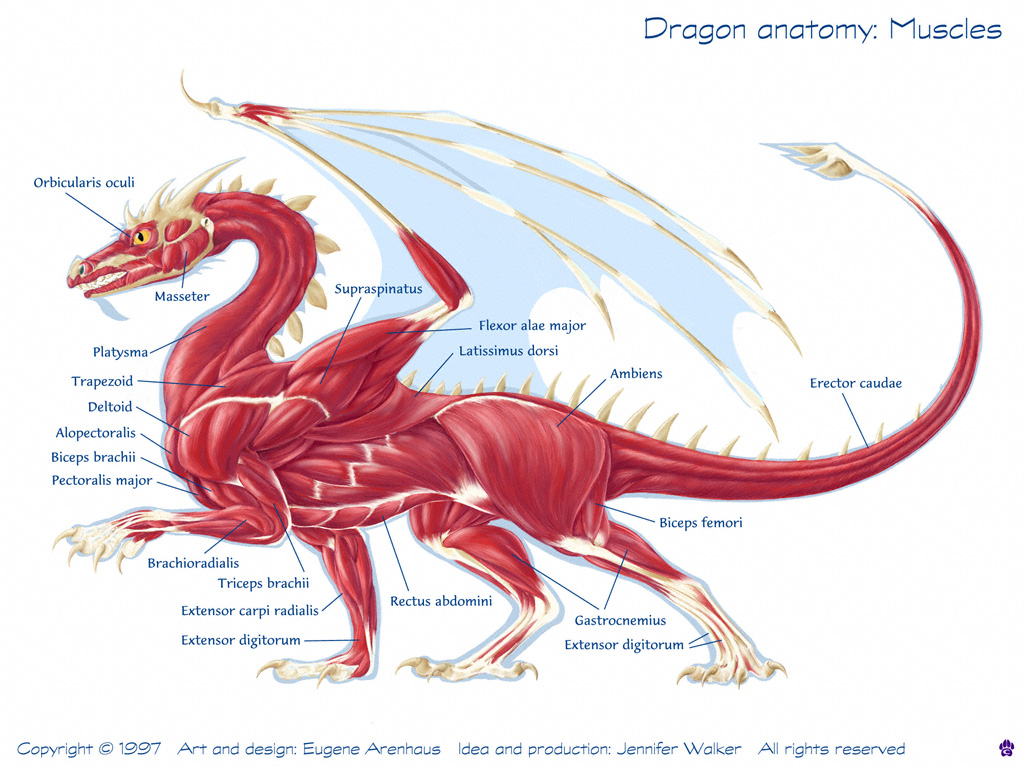Anatomy of a Dragon Wing by blackdragon113 on DeviantArt

RJ Palmer Anatomy of a Dragon
Dragonflies are unusual in their wing movements. Most insects' wings are attached to plates of the chitonous exoskeleton that are, in turn, attached to muscles that move the plates that move the wings. Dragonfly wings, on the other hand, are directly connected to large muscles within the thorax.

Dragon Wing and Chest Anatomy Dragon anatomy, Dragon wings, Dragon art
Skeletal structure consists of a large head, long neck, broad shoulders, thick legs, strong tail and very large wings. The bones are very strong, hollow, and light, allowing for flight. Western dragons have stronger, more powerful muscles. Their masseter muscle is in the jaw and can easily crush bones to bits.

Dragon wing Wing Anatomy, Dragon Anatomy, High Middle Ages, Komodo Dragon, Legendary Creature
The dragon wing is a huge, leathery appendage that is found on several different species of dragon. The wing is usually larger than the dragon's body to accommodate the incredible force needed to lift and maintain flight. BONES The wing is essentially another arm and hand. If you look at the skeleton of a dragon front arm and claws, you will.

Dragon anatomy wing study by turel on DeviantArt
Dragon anatomy is a problematic topic, mainly due to the fact that they're mythical creatures. However I can show you how to design a believable body for this mythical creature based on basic anatomy theory. In this tutorial you'll learn about dragon skeleton, muscles and movement.

Dragon wing anatomy Atlas of Pern Wing Anatomy, Dragonriders Of Pern, Dragon Rider, Dragon
The dragon's form varied from the earliest times. The Chaldean dragon Tiamat had four legs, a scaly body, and wings, whereas the biblical dragon of Revelation, "the old serpent," was many-headed like the Greek Hydra.Because they not only possessed both protective and terror-inspiring qualities but also had decorative effigies, dragons were early used as warlike emblems, as indicated in.

Anatomy of a Dragon Wing by blackdragon113 on DeviantArt
Their skeletons despite being hollow and light are very strong. They have a large head, long neck, and very large wings. The finger bones on their wings are long enough to wrap their flight membrane. As for Eastern dragons, they have a medium sized head, short legs, and a long body. Due to their serpant-like body, the skeleton is very.

Musclesdragonlayout Dragon anatomy, Dragon sketch, Dragon
Snake anatomy, locomotion, and general size. Avian anatomy, covering a survey of bird adaptations and general size. Covering some specific species of interest. Drake anatomy covers the possible variations of this large, four-legged beast. Eastern dragon anatomy covers some possible physiologies for the mythical dragons of the East.

Feathered wing vs Membrane wing anatomy (Dragon) by Sezaii on DeviantArt
Therefore, no limitation is placed on exploring other explanations of Eastern dragon anatomy, since the descriptive quality of the animals attributed here is a demonstration of power and strength, rather than a true biological description of the creature in question.. Flying without Wings. No known species can fly without wings; however,.

Anatomy Of A Dragon Wing by AutumnisBeautiful on DeviantArt
56 and internal anatomy.. dragon y (Perithemis tenera) forwing , hindwing (A)(B) and a male Blue Fronted Dancer damsel y (Argia apicalis) hindwing (C). A dedicated a erence wing nerve branches out into di erent veins from the wing base.. 101 within the wing, and the cell body counts exceed 750 and 350 (see later sections for exact counts.

Dragon Anatomy and Physiology discovered by Draconian.
Dragons are warm-blooded animals, also known as homeothermic, belonging to the reptile family. Their body temperature is regulated internally, with the ability to adapt to various climate conditions. They have unmistakable wings, hence the flying. Dragons don't depend on the sun's warmth, so they have no problems being active day or night.

Dragon Wing, Dongjun Lu on ArtStation at Wings Drawing
Dragon Anatomy 1. Global anatomy of the dragon The skeletal structure of the dragon has a large head, long neck, broad shoulders, thick legs, a powerful tail and large wings. Unlike human bones, dragon bones are very strong, hollow and light. It's true that having hollow and light bones helps a dragon fly.

Dragon anatomy, Dragon drawing, Dragon sketch
Dragon wings are unlike any other wings found in the animal kingdom. They are a marvel of evolution, combining the strength and agility of a bat's wing with the scale-covered membrane of a reptile. These wings are typically attached to the dragon's back, spanning a formidable width that is proportional to their body size.

Dragon wings how to Dragon anatomy, Dragon sketch, Dragon drawing
Dragons are different sizes, of course. They start out as eggs, from 1-4 feet in length, and about half that in diameter. As adults, some species of dragons can be as long as 85 feet, with a wingspan of 170 feet. A dragon's eye has a large iris and a vertical pupil, like a cat.

Western Dragon Muscle Anatomy by TheDragonofDoom Dragon Drawing, Dragon Art, Dragon Bones
Dragons have four legs and two wings. Dragons are covered in scales ranging from green to red to black. Dragon eyes are typically yellow or green. Dragon teeth are sharp and can be up to 12 inches long. Dragon claws are sharp and can be up to 6 inches long. Dragon tongues are forked and can be up to 18 inches long.

Dragon Wings by SammyTorres Anatomy Reference, Drawing Reference Poses, Drawing Poses, Art
A dragon's wings are a shield and a sword, allowing them to whip up violent gusts of wind or create impenetrable barriers to defend their territories. It is through these majestic wings that dragons assert their dominance and establish their authority, a sight both breathtaking and fearsome.

Fourwinged dragon anatomy study by Quentinvcastel on DeviantArt Dragon anatomy, Dragon
The wings of dragonflies are mainly composed of veins and membranes, a typical nanocomposite material. The veins and membranes have a complex design within the wing that give rise to whole-wing characteristics which result in dragonflies being supremely versatile, maneuverable fliers.